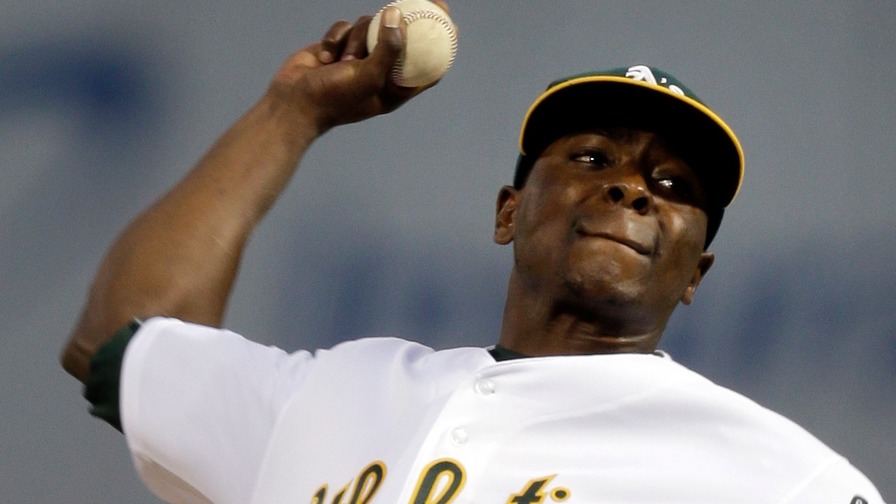Is the Fantasy Baseball Market Too High on Jharel Cotton?

If you've spent draft season channeling expert buzz and pilfering the late rounds for starting pitching talent, you're probably no stranger to the name Jharel Cotton.
The 25-year-old Oakland Athletics righty has become a chic target for 2017 drafters over the past month, with the formerly anonymous hurler being snapped up around pick 250 overall per FantasyPros average draft position (ADP) data despite having less than 30 major league innings on his résumé.
It's the enthusiasm for Cotton in high stakes leagues that seems to be propelling his surprising market ascent. After all, Cotton is going even earlier in National Fantasy Baseball Championship (NFBC) leagues, where's he's being drafted around 230th overall, ahead of more proven commodities like Ivan Nova, Ian Kennedy, and Gio Gonzalez.
The favoring of a young up-and-comer in Cotton over lower-upside veterans doesn't tell us much -- it's natural for fantasy owners to fish for speculative upside in the later rounds, especially in big-money leagues. Still, Cotton's brisk vaulting up draft boards can't simply be written off as a mere case of the "shiny new toy" -- can it? Is there a chance that the market is overvaluing the unproven Oakland righty?
What We Know
It's worth reiterating that Cotton has under 30 innings of major-league pitching under his proverbial belt. This means that he is a truly unknown commodity as a big-league hurler, so our analysis is relegated to an ultra-small sample of advanced statistics, along with surface stats from his minor league career -- there is no Pitchf/x data for the minors, after all.
So, what do we know about Cotton? Well, he is not a high-pedigree prospect -- he was drafted all the way down at pick 626 overall by the Los Angeles Dodgers. In between being drafted by the Dodgers in 2012 and being traded to the Athletics last year in a deal that netted the Dodgers blister-prone quasi-ace Rich Hill, Cotton's reputation grew along with his strikeout rate.
The young righty routinely posted double-digit strikeout-per-nine (K/9) rates across his extended stints in the minors, culminating in an 11.0 K/9 across 97-plus innings for the Dodgers' Triple-A affiliate last year.
Cotton's strong showing was enough to earn him a cup of coffee with Oakland's big-league squad at the tail end of 2016. During his short time in the majors, Cotton showed off the strongest asset in his arsenal -- a devastating high-70-mile-per-hour (MPH) changeup. Hitters registered a measly .098 OPS against Cotton's changeup across a 124-pitch sample. Indeed, that stingy change left hitters absolutely helpless, generating a 55.6 percent grounder rate, along with a 62.5 percent infield fly rate and 29.1 percent strikeout-minus-walk rate.
Cotton's appeal as a fantasy sleeper largely hinges on the potential of this pitch to anchor his arsenal -- after all, Cotton's low-90 MPH fastball isn't exactly a world-beater. It remains to be seen whether Cotton's success with the change is sustainable to anywhere near this extent, or whether those PitchF/x numbers can be attributed to the unfamiliarity of major-league hitters with its unconventional velocity dip.
It also remains to be seen the extent to which Cotton's reliance on velocity deception and weak contact will overly tax what could once again be a league-worst Oakland defense. The spaciousness of Oakland Coliseum should certainly sway some batted-ball luck in Cotton's favor, but then again, that dismal supporting defense could very well render the gains from his home ballpark moot.
Is the Market Too Aggressive?
All of which is to say that, as with any late-round pitching flyer, there are some things that warrant excitement over Cotton and other things that warrant caution.
As for Cotton's current place in the late-round pitching market, it does seem that top-40-fantasy-starter upside is a far less likely a possible outcome for Cotton than it is for, say, Dylan Bundy, Garrett Richards, and Michael Wacha, all of whom are in Cotton's ADP range. And it's possible that we might finish this season wondering why the market was so much higher on Cotton than on fellow Oakland starter Andrew Triggs, available over 100 picks later.
Then again, the intrigue of that lethal changeup does seem to distinguish Cotton among the late-round question marks like Blake Snell, Lance Lynn, and Eduardo Rodriguez, whose workload and effectiveness concerns hardly highlight them as anything approaching stable starter assets and whose price below Cotton in current ADP data thus seems justified.
At the end of the day, perhaps all of this whittles down to matter of preference -- if you are already in on Cotton and his mesmerizing changeup and you want to grab him around the 230th overall ADP that he's established in NFBC, that price doesn't seem unwisely aggressive. At the same time, no one would blame you for taking the glass-half-empty approach and fading Cotton altogether. He is, after all, a largely unknown commodity.
















